How to Choose a Windlass
Selection & Fitting Overview
In order to select the proper windlass for your boat, you need to answer three questions:
- How long is my boat?
- How long is the anchor rode you wish to use and will it fit into your locker?
- How much pulling power should my windlass have?
How Long is My Boat?
Use the selection guide to determine the general size of windlass to be used for your boat length and displacement. For example, if you have a 33ft/ 10m boat, a 700lb (270kg) pull windlass would typically be selected. Adjust the windlass size if necessary, based on your answers to questions two and three below.
How long is the anchor rode you wish to use and will it fit into your locker?
Begin by examining the depth of the anchor locker to determine the amount of 'fall' available. The fall is the vertical distance between the top of the anchor locker and the top of the anchor rode when it is completely stored inside the locker.This measurement is important in determining whether your boat will be best suited for a
vertical or horizontal windlass.
Horizontal Windlass
The Horizontal windlass is a no-nonsense design widely used by boaters requiring optimum performance from their anchoring system. Boaters who frequently anchor, especially in deep water, require a no hassle self-tailing system. The horizontal windlass offers the best performance with small or unusual locker designs. As the anchor rode enters the gypsy it makes a 90º turn and feeds directly into the anchor locker. a minimum fall of 12" (30cm) is recommended.
Vertical Windlass
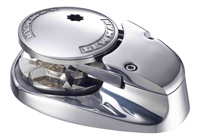
|
Vertical windlasses provide aesthetic value and offer the added security of the anchor rode making a 180º wrap around the gypsy. The inherent design of the vertical windlass requires at least 12"/ 30cm of fall. This is to allow gravity to properly self-tail the anchor rode through a 90º vertical turn into the anchor locker. Additionally, nylon line is lightweight and a short fall in a vertical windlass system might prevent the rode from feeding properly into the locker.
|
Horizontal vs. Vertical Windlass
Horizontal windlasses fit directly over the hause pipe and is positioned in line with the bow roller to ensure a good lead. The rode is retrieved by the windlass and dropped directly into the locker below. Since the rode does not have to change directions it usually goes down the hause pipe neatly without kinking or jamming. Because the motor and gearbox and on deck, they are easily accessible for maintenance, although they are also more exposed to the elements. A horizontal windlass only requires a small hole in the deck to accommodate the windlass shaft, however it does take up more deck space and is usually taller than the vertical windlass. The horizontal windlass should have a "free fall" clutch that allows the anchor and rode to drop without using the motor. However, this can lead to jamming or damage if not used carefully.
Vertical windlass have the motor and gearbox below the deck. This leaves the deck less cluttered unless you select a vertical windlass with a capstan rope drum above the chain wheel (as pictured below on right), but can take up space below decks, which may interfere with living space or with the dimensions of the locker, and can make the motor harder to maintain. Vertical windlasses allow the rode to be led from virtually any direction. The chain rode wraps around the chain wheel, is stripped off the wheel over the hawse hole and falls down into the chain locker. The rope rode wraps
around the drum and leads to the hawse pipe and into the rope locker,
often with a mechanical assist. The configuration of your boat will
determine whether this is a feasible solution for you.
For
either horizontal or vertical windlass, the chain locker should have at
least 12" clearance from the top of the stowed rode to the top of the
locker for the rode to play out properly. More is better. With either
rode it is wise to pull it all out occasionally and run it neatly back
in to avoid tangles. Anytime you are in rough seas there is greater
likelihood of the rode shifting below and becoming entangled on itself.
Before deciding which type of windlass to get, measure your forepeak to
make sure you have enough room for a chain locker.
Horizontal Windlass
|
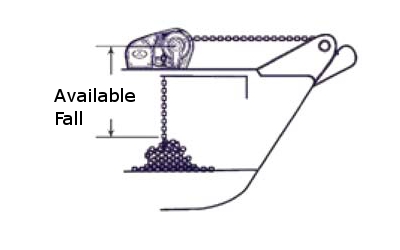
|
Vertical Windlass
|
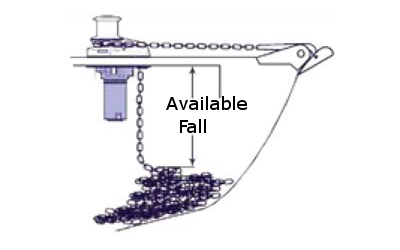
|
3. How much pulling power should my windlass have?
Having selected the vertical or horizontal windlass
sized for your boat length and displacement, the correct windlass pulling power for your needs must be determined using the following formula:
First, determine the total weight of the anchor and rode.
For example:
|
|
The weight of your anchor
|
= 22lb/ 10kg
|
|
|
The weight of your anchor rode comprises
|
|
|
|
15ft/ 4.58m of chain (at 0.74lb/ft or
1.09kg/m)
|
= 11lb/ 5kg
|
|
|
200ft/ 61m of rope (at 0.06lb/ft or 0.09kg/m)
|
= 12lb/ 5.5kg
|
|
|
Total weight of ground tackle
|
=
45lb/
20.5kg
|
Second, take the total weight of the ground tackle and multiply by a factor of three to arrive at the required windlass pulling strength. The factor of three
covers the effects of windage and the speed of tidal current and includes a safety margin for unknown circumstances.
In our example above the required windlass pulling strength is 135lb/61.5kg (3 x 45lbs)/ 20.5kg).
Safety guidelines suggest that the required windlass pulling strength must not exceed 1/3 of the maximum pull capacity of the windlass. Therefore, our selection of a 700lbs/ 270kg pull windlass is correct as the 135lb/ 61.5kg required pulling strength is well below 1/3 the maximum
windlass pull capacity.
Working Load
In a typical anchor recovery situation, the windlass will pass through a number of phases of operation as the boat approaches the anchor and finally breaks it out of the seabed. The load and speed will vary at each phase. For any anchor recovery, the windlass will operate longest in the 'working load' phase and it will experience a significant peak in load during anchor breakout.
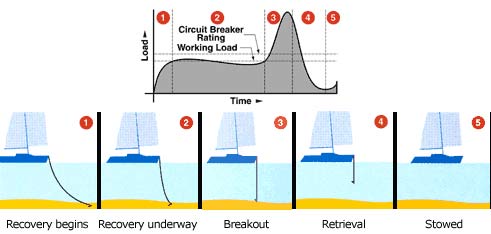
Electrical Circuit Protection
Any installation of electric powered windlasses must be protected with a circuit breaker. This ensures complete protection of the electric motor and installation cables if the windlass is overloaded.
Circuit breakers are normally rated on a 'continuous' basis. This is the load in Amps, under which they will retain electrical contact for an indefinite period. For example, a 70Amp circuit breaker will not trip unless the continuous current exceeds this figure. However, the maximum tolerated current draw may be as much as 250 Amps, but only for a short period of time. All our windlasses carry a recommendation on circuit breaker rating based on continuous operation.
Remember that motoring up to the anchor while using the windlass to retrieve the anchor rode and using the boat to
"break out the anchor" is the proper anchor recovery procedure. Using the windlass to haul the boat to the anchor is not recommended and will result in damage to the windlass and motor.
Safety At Anchor
Windlasses are not designed to hold high loads
while a boat is at anchor. When the windlass is not is use and the boat is at anchor, the anchor rode should be secured using a chain stopper or attached to a load bearing point such as a cleat.
Horizontal Application
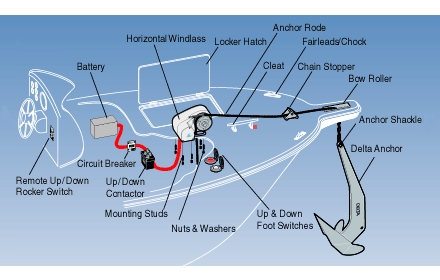
Vertical Application
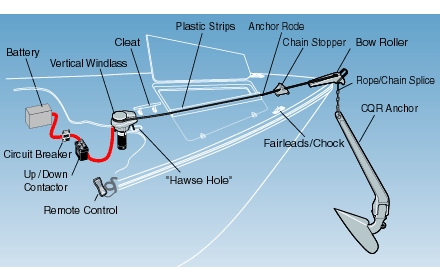
More on How to Choose a Windlass
Make sure you know what the manufacturer has to say about your windlass. Review the specifications to satisfy yourself that the unit you select will meet all your needs.
|